


|
 |
|
|
#26 | |
|
Registered Member
 Join Date: Jul 2010
Location: Austin, TX
Posts: 1,985
|
Quote:
__________________
"Our crystal clear aquaria come nowhere close to the nutrient loads that swirl around natural reefs" Charles Delbeek |
|
|
|

|
|
|
#27 | |
|
Reefer
Join Date: Jan 2011
Location: Pittsburg, CA
Posts: 584
|
Quote:
__________________
Budget reefing is a pipe dream. Current Tank Info: 190 gallon DSA mixed reef, 2 X 250W metal halides, 2 X 80w T5's, SRO 3000 skimmer, and a few other goodies under the hood |
|
|
|

|
|
|
#28 |
|
Reefer
Join Date: Jan 2011
Location: Pittsburg, CA
Posts: 584
|
Day 21 compare
 Day 1 by [url=https://www.flickr.com/photos/145255365@N08/] Day 1 by [url=https://www.flickr.com/photos/145255365@N08/]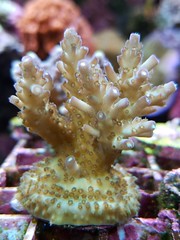 Day 21 by [url=https://www.flickr.com/photos/145255365@N08/] Day 21 by [url=https://www.flickr.com/photos/145255365@N08/] Day 1 by [url=https://www.flickr.com/photos/145255365@N08/] Day 1 by [url=https://www.flickr.com/photos/145255365@N08/] Day 21 by [url=https://www.flickr.com/photos/145255365@N08/] Day 21 by [url=https://www.flickr.com/photos/145255365@N08/]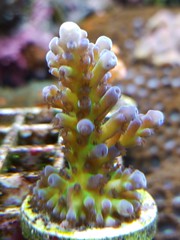 Day 1 by [url=https://www.flickr.com/photos/145255365@N08/] Day 1 by [url=https://www.flickr.com/photos/145255365@N08/]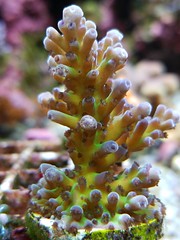 Day 21 by [url=https://www.flickr.com/photos/145255365@N08/] Day 21 by [url=https://www.flickr.com/photos/145255365@N08/]
__________________
Budget reefing is a pipe dream. Current Tank Info: 190 gallon DSA mixed reef, 2 X 250W metal halides, 2 X 80w T5's, SRO 3000 skimmer, and a few other goodies under the hood |
|
|

|
|
|
#29 |
|
Reefer
Join Date: Jan 2011
Location: Pittsburg, CA
Posts: 584
|
The last coral along with a few others in my tank seems to go through a cycle of burnt tips. Its very obvious in the Day 21 picture. Its been happening 6+ months. Seems to happen about every 10 days. Then recovers nicely, then burns again. Not sure why, but NO3 is between 30 and 40.
__________________
Budget reefing is a pipe dream. Current Tank Info: 190 gallon DSA mixed reef, 2 X 250W metal halides, 2 X 80w T5's, SRO 3000 skimmer, and a few other goodies under the hood |
|
|

|
|
|
#30 |
|
RC Mod
 Join Date: Mar 2002
Location: Mountain View, CA, USA
Posts: 88,616
|
Because the corals are getting burnt tips, I'd consider trying to reduce the nutrient load. Although burnt tips are more commonly associated with low nutrient levels, higher levels might cause issues, too.
__________________
Jonathan Bertoni |
|
|

|
|
|
#31 | |
|
Registered Member
 Join Date: Jul 2010
Location: Austin, TX
Posts: 1,985
|
Quote:
Maybe this will help clarify why corals make thier fluorescing protiens, there are at least 4 primary purposes. 1. Photoprotection When the light is too intense for the zooxanthellae the fluorescing oragnelles are placed above them shading them, reducing the amount of light they recieve. As the light levels increase the coral makes more proteins intensifying the colors. http://www.nature.com/nature/journal.../408850a0.html https://researchonline.jcu.edu.au/42...et_al_2006.pdf 2. Photoenhancement. If the light is not bright enough for the zooxantheallae to work at optimum photosynthetic effeceincy the fluorescing organelles are located behind them with respect to the light source so they receive increased light levels. http://www.nature.com/nature/journal.../408850a0.html https://researchonline.jcu.edu.au/42...et_al_2006.pdf (With ULNS methods starving the corals makes them look brighter because the zooxanthellae numbers are restricted reducing thier brown componet to the corals coloration.) 3. As antioxidants. The fluorescing proteins are used to neutralize the free radicals caused by photosythesis. https://www.researchgate.net/publica...s_Antioxidants 4. As an Immune response. Fluorescing proteins are used by the corals immune system to deal with parasites. http://www.jstor.org/stable/25470724...n_tab_contents
__________________
"Our crystal clear aquaria come nowhere close to the nutrient loads that swirl around natural reefs" Charles Delbeek |
|
|
|

|
|
|
#32 |
|
Reefer
Join Date: Jan 2011
Location: Pittsburg, CA
Posts: 584
|
Thanks Tim Fish for the clarification. This is new info for me. cant change the intensity, but I can increase the duration of lighting. I have my halides running for 7 hours. I could try bumping that to 8 or 9 hours.
__________________
Budget reefing is a pipe dream. Current Tank Info: 190 gallon DSA mixed reef, 2 X 250W metal halides, 2 X 80w T5's, SRO 3000 skimmer, and a few other goodies under the hood |
|
|

|
|
|
#33 |
|
Registered Member
Join Date: Mar 2010
Location: NE Miss
Posts: 608
|
Following. Please keep it up.
Sent from my SAMSUNG-SGH-I337 using Tapatalk |
|
|

|
|
|
#34 |
|
Registered Member
Join Date: Aug 2004
Location: Fallbrook, CA
Posts: 3,049
|
I agree! Please do keep up the experiment!
Another thing that might be causing tip burn is Alk. For ULNS 7dkh might be a better value. Whiskey
__________________
This video shows 15 months of coral growth in my tank in a 30 second timelapse: https://youtu.be/bF6C57aTDEo |
|
|

|
|
|
#35 | |
|
Reefer
Join Date: Jan 2011
Location: Pittsburg, CA
Posts: 584
|
Quote:
Thanks, I will.
__________________
Budget reefing is a pipe dream. Current Tank Info: 190 gallon DSA mixed reef, 2 X 250W metal halides, 2 X 80w T5's, SRO 3000 skimmer, and a few other goodies under the hood |
|
|
|

|
|
|
#36 |
|
Registered Member
Join Date: Apr 2016
Location: NJ
Posts: 774
|
Performing PO4 experiment relating to SPS color/growth
My contribution to the discussion. Recently added (2/5/17) SPS frags. My phosphates run roughly .5 (Hanna) and nitrates 50 (Salifert). no algae issues. My Alk has always run high (10-11) (Hanna)
IMG_2799.jpgIMG_3030.jpgIMG_3603.jpg Sent from my iPhone using Tapatalk |
|
|

|
|
|
#37 |
|
Registered Member
Join Date: Apr 2016
Location: NJ
Posts: 774
|
|
|
|

|
|
|
#38 | |
|
Registered Member
Join Date: Jan 2011
Location: Florida, FWB
Posts: 3,389
|
Quote:
Now my question is what method would produce the brighter colors? Protector enhancement? Sent from my iPhone using Tapatalk
__________________
180 Mixed Reef SRO-5000 Skimmer Neptune APEX Gold Kessil AP700/ MP60+6105 Kalk+2 part/ Cheato Fuge Current Tank Info: 180 SPS Dominant |
|
|
|

|
|
|
#39 | |
|
Registered Member
Join Date: Mar 2010
Location: NE Miss
Posts: 608
|
Quote:
But it's debatable whether that is actually good for the coral host, even in theory - set aside the practical difficulty of balancing the tightrope. Sent from my SAMSUNG-SGH-I337 using Tapatalk |
|
|
|

|
|
|
#40 |
|
Reefer
Join Date: Jan 2011
Location: Pittsburg, CA
Posts: 584
|
Day 31
 Day 1 by [url=https://www.flickr.com/photos/145255365@N08/] Day 1 by [url=https://www.flickr.com/photos/145255365@N08/] Day 31 by [url=https://www.flickr.com/photos/145255365@N08/] Day 31 by [url=https://www.flickr.com/photos/145255365@N08/] Day 1 by [url=https://www.flickr.com/photos/145255365@N08/] Day 1 by [url=https://www.flickr.com/photos/145255365@N08/] Day 31 by [url=https://www.flickr.com/photos/145255365@N08/] Day 31 by [url=https://www.flickr.com/photos/145255365@N08/] Day 1 by [url=https://www.flickr.com/photos/145255365@N08/] Day 1 by [url=https://www.flickr.com/photos/145255365@N08/]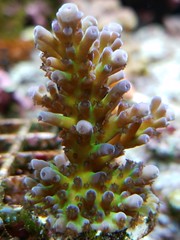 Day 31 by [url=https://www.flickr.com/photos/145255365@N08/] Day 31 by [url=https://www.flickr.com/photos/145255365@N08/]Since the last update, I increased lighting from 6 hours to 8 hours a day. When I had low nutrients in the past, everything would bleach out. Now corals seem to be taking the increased lighting with no ill effects.
__________________
Budget reefing is a pipe dream. Current Tank Info: 190 gallon DSA mixed reef, 2 X 250W metal halides, 2 X 80w T5's, SRO 3000 skimmer, and a few other goodies under the hood |
|
|

|
|
|
#41 |
|
RC Mod
 Join Date: Mar 2002
Location: Mountain View, CA, USA
Posts: 88,616
|
It's interesting that you can increase the lighting. I'll be interested to see how this shapes up.
__________________
Jonathan Bertoni |
|
|

|
|
|
#42 | |
|
Registered Member
Join Date: Mar 2010
Location: NE Miss
Posts: 608
|
Quote:
This paper argues precisely that P out of balance too low makes coral more susceptible to bleaching. Cool that you seem to be confirming this in a tank setting.  "P starvation reduces the photosynthetic capacity (Fv/Fm < 0.5) and renders the corals susceptible to heat/light stress. Alternatively, P starvation might result when zooxanthellae growing under nutrient replete conditions are deprived of P while nitrogen levels remain high." |
|
|
|

|
|
|
#43 | |
|
Registered Member
Join Date: Dec 2015
Posts: 61
|
Quote:
|
|
|
|

|
|
|
#44 |
|
Reefer
Join Date: Jan 2011
Location: Pittsburg, CA
Posts: 584
|
Day 39 comparison
 Day 1 by [url=https://www.flickr.com/photos/145255365@N08/] Day 1 by [url=https://www.flickr.com/photos/145255365@N08/]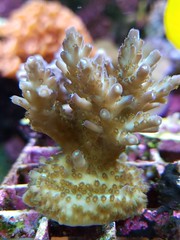 Day 39 by [url=https://www.flickr.com/photos/145255365@N08/] Day 39 by [url=https://www.flickr.com/photos/145255365@N08/] Day 1 by [url=https://www.flickr.com/photos/145255365@N08/] Day 1 by [url=https://www.flickr.com/photos/145255365@N08/] Day 39 by [url=https://www.flickr.com/photos/145255365@N08/] Day 39 by [url=https://www.flickr.com/photos/145255365@N08/] Day 1 by [url=https://www.flickr.com/photos/145255365@N08/] Day 1 by [url=https://www.flickr.com/photos/145255365@N08/]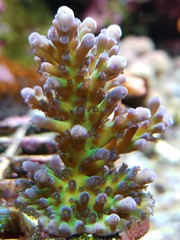 Day 39 by [url=https://www.flickr.com/photos/145255365@N08/] Day 39 by [url=https://www.flickr.com/photos/145255365@N08/]
__________________
Budget reefing is a pipe dream. Current Tank Info: 190 gallon DSA mixed reef, 2 X 250W metal halides, 2 X 80w T5's, SRO 3000 skimmer, and a few other goodies under the hood |
|
|

|
|
|
#45 |
|
Reefer
Join Date: Jan 2011
Location: Pittsburg, CA
Posts: 584
|
Overall a lot of growth. No noticeable color change IMO. Pics are taken under 2 x SE 250w, 14k Hamilton, halides. My frag rack is getting heavy, so I think its time to sell them off.
__________________
Budget reefing is a pipe dream. Current Tank Info: 190 gallon DSA mixed reef, 2 X 250W metal halides, 2 X 80w T5's, SRO 3000 skimmer, and a few other goodies under the hood Last edited by greengeco82; 05/06/2017 at 03:52 PM. |
|
|

|
|
|
#46 | |
|
Registered Member
 Join Date: Jul 2010
Location: Austin, TX
Posts: 1,985
|
Quote:
Just an update, I was reviewing some stuff and found a refference link was no longer valid. New link is in red.
__________________
"Our crystal clear aquaria come nowhere close to the nutrient loads that swirl around natural reefs" Charles Delbeek |
|
|
|

|
 |
| Thread Tools | |
|
|